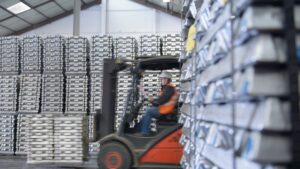Why silver still has plenty more road to run

Picture: Getty Images
Silver continues to prove its use beyond just a currency or a safe haven investment, with new applications expected to see a tripling of demand in the next decade. It is also starting to beat gold at its own game.
The precious metal is slowly becoming better known for its antiviral properties and its usefulness in monitoring a person’s vital signs, as well as its importance in solar panels due to it having the highest electrical and thermal conductivity of all metals.
But predictions for silver’s rise in value also lies in the increasing demand in the next generation 5G technology.
According to Washington-headquartered non-profit industry body The Silver Institute, the electronic components that enable 5G technology will rely strongly on silver to make the global 5G platform perform seamlessly.
Right now, 5G-related silver demand only amounts to about 7.5 million oz given the industry is in its infancy.
But The Silver Institute estimates that with the ramp-up in the rollout of 5G in the coming years, the amount of silver required will climb to around 16 million oz by 2025 and 23 million oz by 2030. That’s more than 3x the current demand.
As a comparison, silver’s use in the once emerging photovoltaic industry stood at about 40 million oz in 2010, and by 2018 it had reached 80.5 million oz.
And market watchers are extremely bullish on the outlook for silver.
In its September Global Commodities Quarterly, Citi said it could see $US40 ($52.77) an oz within six to 12 months with upside cases of US$50/oz and even US$100/oz based on technical analysis.
At the moment, silver is trading at about $US25/oz — more than double its lowest point in 2020 of just under $US12/oz in March.
Silver is also starting to outperform gold. Last Tuesday the silver price climbed 2 per cent to $US24.55, while gold only advanced 1.18 per cent to $US1853.80.
This is a key trend that emerged during the only two times in history that silver has run hard – both following recessions.
The first time the price went from sub-$US5 an ounce during the 1970s recession to almost $US50 an ounce in the early 80s. The second time, following the GFC, silver again ran hard, from below $US10 an ounce to over $US45 an ounce in 2011.
These short-term percentage gains at the time far exceeded gold’s gains during the same timeframes.
Add to that the fact the gold-silver ratio continues to narrow and all signs point to a silver bull run.
The gold-silver ratio is the number of ounces of silver it takes to buy one ounce of gold.
Any widening in the ratio above the long-term average of 63 is generally taken as a cue to buy silver as it begins to look cheap in relative terms against gold. In March this year the ratio hit a fresh peak of over 120 before beginning a fairly swift descent. It’s currently sitting at around 73, not too far off its five-year low of 65.
Increasing demand and a rising silver price is beneficial for the ASX-listed stocks getting close to production or with advanced projects.
Ahead of the pack
Manuka Resources (ASX:MKR), which listed in July after raising $7m and has received strong investor interest to contribute a further $7m to the coffers, may just be the closest to moving into actual production.
The company has witnessed strong investor interest since listing and its shares are almost double the IPO price at 38.5c.
Manuka purchased the Wonawinta silver project in NSW’s Cobar district out of administration in late 2016, which included an 850,000 tonne-per-annum mill that has since been refurbished.
The mill has been treating gold ore from Manuka’s Mt Boppy mine 150km away since April, but is set to transition to producing silver next year.
The company expects to produce 900,000oz of silver from 500,000 tonnes of stockpiled ore at Wonawinta over six to nine months before moving on to mine the project’s silver oxide resource.
Forecast production from the oxide resource is more than 2 million oz of silver a year over at least four years.
Manuka has been undertaking drilling at Wonawinta to upgrade the existing 52 million oz inferred mineral resource to the higher confidence measured and indicated categories as well as to test the project’s deeper sulphide mineralisation.
Silver Mines (ASX:SVL), meanwhile, is close to finalising approvals for its Bowdens Silver project in central New South Wales, the largest undeveloped silver deposit in Australia.
The company has jumped over 330 per cent in 2020 to 22.5c.
In parallel with negotiating approvals, Silver Mines has been working on optimising results of a 2018 feasibility study incorporating a higher silver price as well as conducting further drilling to identify higher grade zones of mineralisation at Bowdens that may support an underground mining scenario beyond the planned open pit.
The feasibility study envisaged an open pit mine producing an average of 3.4 million ounces of silver, 6900 tonnes of zinc and 5100 tonnes of lead a year for an initial 16 years. The estimated capital cost was $246m.
Funding for Bowdens is likely to come from North America, where there is a deeper understanding of the silver market and royalty streaming companies offer an alternative source of development finance.
A bonanza-grade winner
Investigator Resources (ASX:IVR) owns the Paris silver project, which the company says is the highest grade non-by-product undeveloped silver project in Australia.
The company has run up nearly 590 per cent from its low point of 0.9c in 2020 to 6.2c.
Investigator announced just last week ‘bonanza’ silver hits from the project of 2m at 6,247 grams per tonne (g/t), including 1m at a massive 12,447g/t, from only 29m.
As a rule of thumb, anything over 50g/t is considered high-grade and while there is no official definition for a bonanza grade (just a way of describing speccy finds), it’s safe to say this would definitely make it into the bonanza category.
Managing director Andrew McIlwain said the first “ultra-high-grade” sample result of 12,447g/t certainly outstripped what he had previously referred to as “eyewatering” grades.
The Paris project contains a resource of 9.3 million tonnes at 139g/t silver and 0.6 per cent lead for 42 million oz of contained silver and 55,000 tonnes of contained lead.
Investigator says Paris is a shallow deposit of high-grade silver amenable to simple open pit mining should a decision be made to progress to development.
Against the backdrop of the rising silver price, the company is progressing a pre-feasibility study (PFS) that is expected to be completed by June next year.
Silver by-product advantage
There are a bunch more ASX-listed juniors with silver as a by-product in their portfolio.
One is Pacifico Minerals (ASX:PMY), which has witnessed strong share price appreciation in 2020 — notching a gain of 800 per cent from a 52-week low of 0.2c to just below 2c.
The company completed a phase-four drilling program at its Sorby Hills lead-silver-zinc project in WA in November.
The project hosts a resource of 44.1 million tonnes at 3.3 per cent lead, 38g/t silver and 0.5 per cent zinc and proved and probable reserves of 13.6 million tonnes at 3.6 per cent lead and 40g/t silver.
A PFS completed in August indicated Sorby Hills could sustain an initial 10 years of production at an output of 50,000 tonnes of lead and 1.5 million oz of silver each year.
That would generate EBITDA (earnings before interest, tax, depreciation and amortisation) of $75m each year.
The mine would cost $183m upfront to build and is estimated to have a pre-tax net present value of $303m and internal rate of return of 46 per cent, with a 1.6-year payback.
Both NPV and IRR are metrics used to assess the profitability of a project – the higher the number is above 0, the more profitable it will be.
Mithril Resources (ASX:MTH) has also been a top performer this year, with its share price up 375 per cent from a 52-week low of 0.4c to 1.9c.
The company is advancing its Cometa project in the Copalquin gold-silver district of Mexico. Earlier in December it reported high-grade intersections of 9.35m at 7.84g/t gold and 138.1g/t silver, including 4m at 16.44g/t gold and 286.8g/t silver, from 206m during a deeper drilling program at the El Refugio target.
“El Refugio is shaping up as a very strong and important target in the Copalquin district,” managing director and CEO John Skeet said following the news.
“It is clear we are now seeing the top of a large system for gold and silver and future drilling is being designed to drill deeper and to test the extent of the structure at the El Refugio target.
“The several dozen historic mines and workings across the district, extensive rock chip sampling and the successful maiden drill program continue to indicate a large epithermal gold silver system in the district.”
At Stockhead, we tell it like it is. While Manuka Resources and Silver Mines are Stockhead advertisers, they did not sponsor this article.
UNLOCK INSIGHTS
Discover the untold stories of emerging ASX stocks.
Daily news and expert analysis, it's free to subscribe.
By proceeding, you confirm you understand that we handle personal information in accordance with our Privacy Policy.








